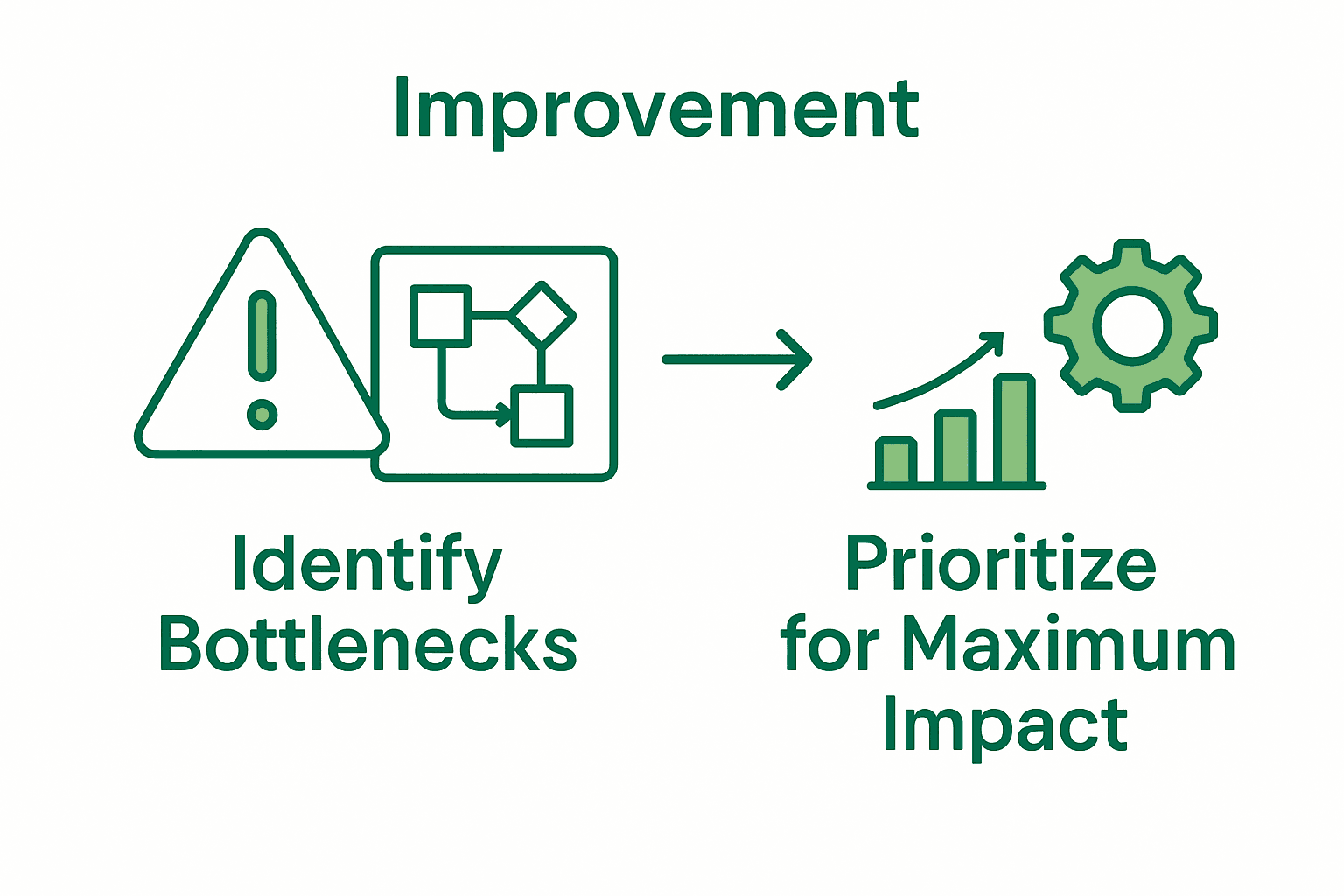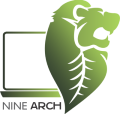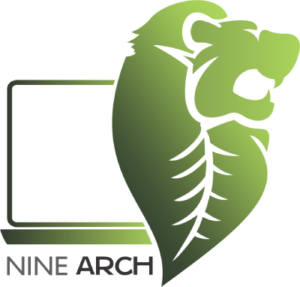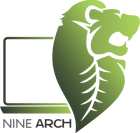Nearly 60 percent of american businesses report losing valuable time each week because of inefficient processes. Streamlining operations has become more than a trend—it is a necessity for staying competitive. Knowing where bottlenecks hide and how to resolve them can make the difference between falling behind and thriving. This guide delivers concrete steps for businesses determined to boost productivity, make smart use of resources, and create smoother day-to-day workflows.
Step 1: Assess Current Business Processes for Bottlenecks
Understanding your organization’s workflow bottlenecks is the first critical step toward improving operational efficiency. This assessment will help you identify specific areas where work gets stuck, slowing down productivity and increasing unnecessary complexity.
To conduct a thorough process assessment, start by mapping out your current workflows in detail. Analyze each step systematically and look for signs of inefficiency such as recurring delays, redundant tasks, or points where work consistently stalls. The business process documentation guide can provide additional strategies for creating comprehensive workflow diagrams.
Key indicators of potential bottlenecks include tasks that require excessive approvals, manual data entry processes, communication gaps between departments, and resource constraints. Pay special attention to sections where work accumulates or team members spend disproportionate amounts of time. Quantitative metrics like cycle times, wait times, and resource utilization rates can provide objective insights into process performance.
Pro Tip: Use cross functional team discussions to uncover hidden process inefficiencies. Different perspectives can reveal bottlenecks that might not be immediately apparent from a single viewpoint.
Once you have identified potential bottlenecks, prioritize them based on their impact on overall business performance. Some disruptions create more significant downstream effects than others, so focus on resolving issues that provide the most substantial operational improvements. The next step will involve designing targeted interventions to streamline these problematic workflow segments.

Step 2: Identify Key Functions for Outsourcing or Automation
Successfully streamlining your business operations requires a strategic approach to identifying which functions are best suited for outsourcing or automation. Your goal is to pinpoint tasks that consume significant resources while offering minimal strategic value to your core business objectives.
Start by conducting a comprehensive audit of your current business processes. Look for repetitive administrative tasks, data entry functions, customer support activities, and standard operational procedures that follow predictable patterns. Why outsource non-core functions can provide deeper insights into selecting the right candidates for external support or technological intervention. Focus on functions that meet specific criteria such as standardized workflows, clear performance metrics, and minimal need for complex decision making.
Prioritize tasks based on their potential return on investment. Consider elements like time savings, cost reduction, error minimization, and scalability. Typical candidates include payroll processing, technical support, digital marketing analytics, research compilation, and routine compliance documentation. Remember that successful outsourcing or automation is not about replacing human talent but about strategically reallocating human resources toward higher value strategic initiatives.

Pro Tip: Always conduct a pilot test before fully implementing outsourcing or automation solutions. This allows you to validate performance, identify potential challenges, and refine your approach before making comprehensive organizational changes.
As you move forward, develop clear performance benchmarks and communication protocols to ensure seamless integration of outsourced or automated functions with your existing operational framework. The next step will involve selecting the most appropriate partners or technological solutions to execute your strategic optimization plan.
Step 3: Implement Remote Workforce and Digital Solutions
Implementing remote workforce and digital solutions represents a transformative strategy for enhancing operational efficiency and creating a more flexible organizational structure. Your objective is to integrate technological platforms and remote work methodologies that enable seamless collaboration and productivity across distributed teams.
Begin by selecting robust digital collaboration tools that support real-time communication, project management, and performance tracking. Outsourced IT vs In-House Guide can help you understand the technological infrastructure needed for effective remote workforce management. Focus on platforms that offer secure file sharing, video conferencing, task assignment, and comprehensive analytics to monitor team performance and maintain accountability.
Establish clear remote work protocols that define expectations for communication, availability, deliverable standards, and performance metrics. This includes creating comprehensive onboarding processes for remote team members, defining communication channels, setting up regular check-ins, and implementing transparent performance evaluation systems. Consider developing role specific digital workflows that leverage each team members strengths while maintaining consistent operational standards.
Pro Tip: Invest in cybersecurity training and robust digital infrastructure to protect sensitive information when transitioning to remote work models. Implementing multi factor authentication and secure cloud based collaboration tools will help mitigate potential security risks.
As you implement these digital solutions, remain adaptable and open to continuous improvement.
Regular feedback from team members and ongoing assessment of your digital infrastructure will help you refine your remote work strategy. The next step will involve establishing performance tracking mechanisms to ensure your remote workforce maintains high productivity and alignment with organizational goals.
Step 4: Standardize and Optimize Operational Workflows
Streamlining your business operations requires a systematic approach to standardizing and optimizing workflows across your organization. Your primary goal is to create consistent, efficient processes that minimize redundancies and maximize productivity through strategic workflow design and continuous improvement.
Implement a comprehensive workflow mapping strategy that documents each step of your key business processes. Outsource Repetitive Tasks Guide for Seamless Efficiency can provide additional insights into identifying and eliminating non value adding activities. Analyze each workflow critically to identify bottlenecks, unnecessary steps, and potential areas for automation or process redesign. Use techniques from the Bottleneck Resolution Method which combines elements of lean management and constraint theory to create more streamlined operational approaches.
Develop standardized operating procedures that provide clear guidelines for each critical business function. These procedures should include detailed step by step instructions, performance expectations, quality control checkpoints, and accountability measures. Create visual workflow diagrams that help team members understand the entire process and their specific role within it. Implement digital tools that support real time process tracking and enable quick identification of potential inefficiencies.
Pro Tip: Regularly schedule process review meetings with cross functional teams to gather insights and continuously refine your workflows. Different perspectives can uncover improvement opportunities that might not be apparent from a single viewpoint.
As you standardize and optimize your workflows, remember that this is an ongoing process. Remain open to feedback, track performance metrics, and be prepared to make incremental improvements. The next step will involve establishing robust performance measurement systems to ensure your optimized workflows deliver the expected operational efficiency.
Step 5: Monitor Performance and Continuously Refine Systems
Continuous performance monitoring and system refinement are critical for maintaining operational excellence and ensuring your business remains agile and competitive. Your objective is to develop a robust framework for tracking key performance indicators, identifying improvement opportunities, and implementing strategic adjustments.
Establish a comprehensive performance tracking system that captures both quantitative and qualitative metrics across your organization. Key Performance Tracking Guide can help you design measurement frameworks that provide meaningful insights into operational efficiency. Focus on developing key performance indicators that reflect critical aspects of your business such as productivity, quality, customer satisfaction, resource utilization, and process cycle times. Use advanced analytics tools to transform raw data into actionable intelligence that drives strategic decision making.
Implement a structured feedback mechanism that encourages continuous input from team members at all levels of the organization. Create regular review sessions where cross functional teams can discuss performance data, share observations, and collaborate on potential improvements. Develop a culture of transparency where performance metrics are openly shared and employees are empowered to suggest process enhancements. Use methodologies like the Bottleneck Resolution Method to systematically evaluate and address potential constraints in your operational workflows.
Pro Tip: Develop a balanced scorecard approach that evaluates performance across multiple dimensions financial, operational, customer related, and learning growth to ensure a holistic view of organizational effectiveness.
Remember that performance monitoring is an iterative process. Stay flexible, be willing to experiment with new approaches, and view each performance review as an opportunity for incremental improvement. The goal is not perfection but continuous progression toward greater operational efficiency and organizational resilience.
Unlock Seamless Efficiency with Expert Outsourcing Solutions
If your business struggles with bottlenecks, repetitive tasks, or the challenge of managing a remote workforce, you are not alone. This article clearly points out the need to identify inefficiencies, outsource non-core functions, and implement digital solutions that drive productivity and cost savings. At NineArchs LLC, we specialize in helping businesses like yours overcome these exact challenges. Whether it’s business process outsourcing, custom software development, or expert virtual assistance, our tailored remote workforce solutions empower you to streamline operations without sacrificing quality or control.

Discover how partnering with NineArchs LLC can accelerate your journey toward maximum operational efficiency. Connect today through our easy-to-use contact page for a personalized consultation. Explore our outsourcing services designed to reduce costs and improve productivity. Act now to transform your workflows and ensure your business is ready for future growth. Your streamlined operations start here.
Frequently Asked Questions
How can I identify bottlenecks in my business processes?
Assess your workflows by mapping out each step and looking for signs of delays or inefficiencies. Focus on areas with excessive approvals or manual tasks, and gather team input to uncover hidden issues.
What tasks should I consider for outsourcing or automation?
Identify repetitive and resource-consuming tasks that do not add strategic value, like payroll processing or data entry. Conduct an audit of your tasks and prioritize them based on potential time savings and impact.
How do I implement a remote workforce effectively?
Select digital collaboration tools that support communication and task management among your remote team. Establish clear work protocols and regular check-ins to maintain accountability and performance standards.
What steps can I take to standardize my operational workflows?
Document current processes by creating detailed workflow maps and standard operating procedures. Focus on eliminating non-value-added activities to streamline operations and improve overall efficiency.
How should I monitor performance after streamlining operations?
Develop a performance tracking system that includes key performance indicators like productivity and customer satisfaction. Schedule regular review sessions to discuss insights and continuously refine your processes for ongoing improvement.









